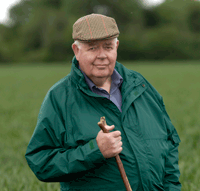David Richardson finds Morocco full of potential

My preconceived notion of Morocco was influenced by films about the French Foreign Legion seen in my youth.
In my imagination, it consisted of sand with an occasional oasis and a few colourful cities with dubious reputations.
At the risk of dating myself I could almost hear Anne Ziegler and Webster Booth singing duets from the stage musical The Desert Song.
I wasn’t entirely wrong. Eighty percent of the land area is desert and semi-arid that would produce nothing without irrigation. The Foreign Legion isn’t there anymore – it shifted to France when the French occupation ended in 1956. And the nearest to my romantic concepts were the souks, or markets, selling everything imaginable, in most big cities and a rather respectable belly dancer who entertained the Farmers Weekly party after dinner one evening.
But, as we discovered, Morocco is much more than that. And agriculture is a vital part of its economy, accounting for nearly 40% of the labour force (most of it self-employed on small farms with a handful of cows and powered only by donkeys) and producing some 15% to 20% of GDP. Despite that – and a climate that favours a range of temperate and semi-tropical crops – the country still has to import a great deal of food for its 33 million population. Efforts are being made to increase domestic production and reduce imports.
These are being led by King Mohammed VI, who is all-powerful, with the ability to appoint and dismiss government ministers. But he appears to use his power wisely and the fact that Morocco, almost uniquely among North African Arab nations, has been virtually free of riots in recent weeks is a measure of his popularity and what he is trying to achieve.
One of his most exciting initiatives, launched three years ago, is Maroc Vert or Moroccan Green Plan. Its objectives are to develop and modernise Moroccan agriculture over 10 to 15 years; to persuade farmers, large and small, to work together in both production and marketing; to increase yields and productivity in every agricultural sector; to promote private investment in the industry; to triple the value of farm production and to increase rural employment by 50%.
It’s an ambitious project and has wide support, although small farmers are reluctant to change their ways because, although many live below the official poverty line, they don’t want to lose their independence. Farmers don’t pay tax at present and some worry that if they start making money this will change. Meanwhile, there are generous grants to help with a range of activities, from funding irrigation from the increasing number of state-constructed reservoirs to buying better seeds and breeding better livestock, all with the aim of increasing production.
We saw examples of how these objectives were being pursued wherever we went. One, for instance, was at the Chamber of Agriculture in Fes, whose officers arranged a wonderful reception for us to to pick our brains on how best to achieve culture change among traditionalists.
We offered a few ideas, but thought the comprehensive system of grants, subsidies and tax breaks already in place should help. Indeed, because of these, the country has already attracted investment from abroad and has benefited from this in recent years.
We concluded if Maroc Vert works the country has the potential – provided the water doesn’t run out – to significantly increase self-sufficiency for food.
In any case, we found Morocco fascinating and hospitable and I strongly recommend others to go and see it for themselves.
David Richardson farms about 400ha (1000 acres) of arable land near Norwich in Norfolk in partnership with his wife, Lorna. His son, Rob, is farm manager.
Read more from Richard and our other Farmers Weekly columnists.
